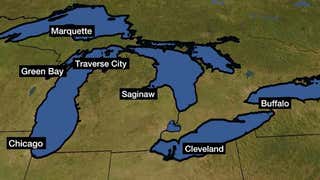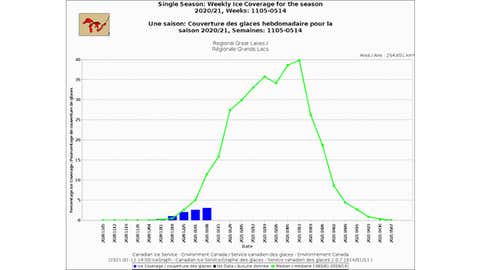
At a Glance
- Only a few small parts of the Great Lakes are ice covered right now.
- Ice cover usually ramps up this time of year, but won't happen in the near future.
- The lack of ice cover could have two main impacts through spring.
About halfway through January there is still precious little ice cover on the Great Lakes, and that could have significant impacts on the rest of winter and spring.
At a time when the Great Lakes historically sees the greatest gains in ice cover, this season has yet to get on the ice-making train.
Only 2.1% of the Great Lakes are covered by ice, behind the average-to-date of about 12%, according to an analysis from NOAA's Great Lakes Environmental Research Laboratory.
SPONSORED: New year, new sale on Gravity Blankets
Last year's ice cover was also behind at this point, but there was about 5% ice cover then.

Currently, ice is only in shallower bays – in parts of Green Bay and Saginaw Bay – as well as in a few nearshore areas along Lake Superior in northern Wisconsin and Michigan's Upper Peninsula.

Ice cover on the Great Lakes is most directly linked to temperature. If it’s warm, ice won't form.
Temperature departures for Great Lakes locations since Dec. 1 have been 3 to 8 degrees above average, according to the Southeast Regional Climate Center.
The warm weather has also contributed to a snowfall deficit in the region.
Marquette, Michigan, one of the snowiest place in the U.S., is running a snowfall deficit nearing 3 feet.
Much of that has to due to the lack of lake-effect snow, which needs to have cold air moving over the lakes to develop.
Other Great Lakes locations are showing the same lack of snow.
Marquette, Buffalo and Erie, all snowfall giants, have received a half inch of snow or less so far in January, typically the snowiest month for these locations.

The short-term outlook doesn't look promising for significant ice cover growth. The latest 6-10 day NOAA temperature outlook shows above-average temperatures across the Great Lakes region.

Potential Impacts Through Spring
What does all of this mean for Great Lakes residents?
A lack of ice cover means more open water to release heat and moisture into any cold air that passes over the lakes. That could lead to an increased chance for lake-effect snow later in the season on lakes such as Erie that typically ice over by early February.
You can have relatively warm open water as a source for the moisture to produce the snow, but if cold air masses don't move over that warm, ice-free water, you won’t get snow.
Another concern is shore protection. A stable, well-established build-up of ice protects the shore from erosion during winter storms. Without it, lakeshore properties are more vulnerable.

Water levels on the Great Lakes are all below last year’s record or near-record levels.
However, they are all above average for this time of the year. Lake Erie and the Lake Michigan-Huron complex are over 2 feet above average.
The combination of less ice cover to protect shorelines and higher water levels increases the potential for water and wave damage if storms with strong winds impact the region.
The Weather Company’s primary journalistic mission is to report on breaking weather news, the environment and the importance of science to our lives. This story does not necessarily represent the position of our parent company, IBM.



